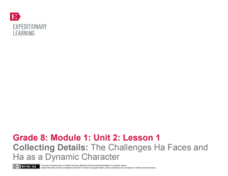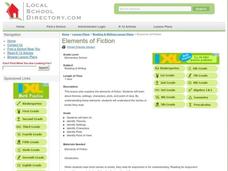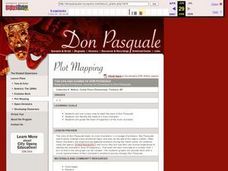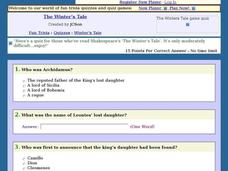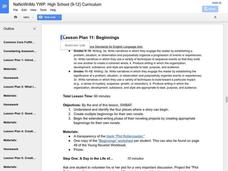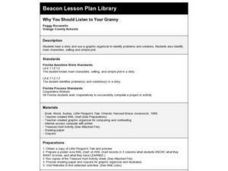EngageNY
Modeling Entry Task, Reading Notes, and Reading Strategies for Lyddie
Readers understand a text better when they discuss it with someone else. Scholars continue reading the novel Lyddie by Katherine Paterson, engaging in text-related discussions with five classmates. Next, they add to their chapter three...
EngageNY
Collecting Details: The Challenges Ha Faces and Ha as a Dynamic Character
What is a dynamic character? Using an interesting resource, scholars set out to answer the question. They create graphic organizers to collect details about character development as they read the novel Inside Out & Back Again. They...
Pace University
Short Stories
A reading of Kevin Lamb's short story "Lost in the Woods" launches a study of how writers use elements such as foreshadowing, mood, character development, setting, and conflict to engage readers. Class members then demonstrate what they...
Curated OER
Plot and Conflict List
In this language arts worksheet, students use this check sheet and list to help identify the main problem, character's goal and resolution in a story.
Curated OER
Story Plot Terms
This literary terms handout defines introduction, rising action, climax, falling action, and denouement.
Curated OER
Elements of Fiction
Students identify key story elements in a fiction text. In this literacy lesson, students are introduced to the various elements of fiction such as the setting, plot, and theme. Students read a short story of their choice and identify...
Curated OER
Of Mice and Men: Fun Trivia Quiz
Quiz your class on basic comprehension of the novel Of Mice and Men, by John Steinbeck. This resource is made up of ten straightforward multiple choice questions about the characters, setting, and plot of the novel. Learners receive...
Curated OER
Story Elements
Review story elements with your class using this resource. Learners can take a story they have read as a class and identify story elements. They focus on characters, setting, the introduction, and plot. Then, they use graphic organizers...
Curated OER
The Ups and Downs of don Pasquale: Mapping the Emotional Journey of Characters in Don Pasquale
Students listen to and retell the story of Don Pasquale. They evaluate the emotions of the main characters. Students create a graph of the emotions of Don Pasquale.
Curated OER
Much Ado About Nothing: Fun Trivia Quiz
Check to see if your pupils can identify characters and basic plot points from Shakespeare's Much Ado About Nothing with this online interactive quiz. While the content is not innovative, this basic quiz could be helpful as a sponge or...
Curated OER
The Winter's Tale: Fun Trivia Quiz
This online quiz asks basic comprehension questions for Shakespeare's A Winter's Tale. Test-takers answer fifteen multiple choice and fill-in-the-blank questions, and receive immediate feedback. These basic questions focus mainly on...
Curated OER
The Too Small House: Story and Craft Activity
Engage students in setting and character with this story and craft activity set. To begin the activity, learners read the short story "The Too Small House." They then cut out and color a picture of the house and paper figures of the...
Curated OER
Academic Vocabulary
Arm your writers with an arsenal of literary terms. With definitions of everything from plot structure and figurative language to point-of-view and types of irony, learners will gain an understanding of elements in stories and be able to...
Book Units Teacher
Story Elements
This 97-slide PowerPoint uses Charles Dickens's A Christmas Carol, Wilson Rawls, Where the Red Fern Grows, and Jeanne DuPrau's The City of Ember, to illustrate the elements of a story. Setting, plot, characterization (both flat and...
Greater Grace Christian Academy
Cereal Box Book Report
Need a creative idea for an elementary book report? Use a cereal box project to engage your readers beyond plot, setting, and characters. The lesson includes templates for the project and examples from Charlie and the Chocolate...
Curated OER
"The Gunny Wolf": American Folktale
While you tell the story of "The Gunny Wolf," your class will actively participate by asking questions and clarifying. Next, they answer questions about the story to increase comprehension before creating a storyboard to document the...
Have Fun Teaching
Silly Stories
Young writers get a jump start on story telling by selecting a plot, a setting, and multiple character cards and then use these basic elements to create a tale.
Internet Archive
Daz 4 Zoe
It is rough trying to make your way through Romeo and Juliet with young readers. The language can set up barriers that prevent conversations about the conflicts and themes. Robert Swindells Daz 4 Zoe is similar in structure and theme,...
Curated OER
Lesson Plan 11: Beginnings
Every good novel needs a solid beginning! Setting the stage can have your budding authors stumped, so use this lesson to get them thinking. After examining the plot rollercoaster image (included) they consider the four places their story...
Curated OER
Lesson Plan 17: Novel, Take 2
It's all about using peer resources in this writing process lesson, which includes a fantastic novel revision worksheet packet. Learners have read a partner's story draft the night before, and groups have a "lightning round of praise"...
Scholastic
A Reading Guide to A Wrinkle in Time
Accompany a reading of Madeleine L'Engle's classic tale, A Wrinkle in Time, with a detailed guide equipped with 15 informative and useful chapters. Scholars discover who the author is, why she wrote the book, and crucial story elements...
Curated OER
Identifing Elements of Narrative Writing
Students explore the concepts of narrative writing. They identify the basic elements in narrative writing such as the setting description, characters, conflict, climax and resolution. Using five adjectives from a previous spelling unit,...
Curated OER
Story Planner
In this pre-writing graphic organizer, students fill in a chart with the characters, setting, plot, beginning and ending that they will use to write a story.
Curated OER
WHY YOU SHOULD LISTEN TO YOUR GRANNY
Learners hear a story and use a graphic organizer to identify problems and solutions. They also identify main characters, setting and simple plot. They illustrate one situation when they should listen to their parents.



